For all the fun we’ve been having, something has been missing: any substantial contact with Lithuanians, Latvians, or Estonians. It’s so easy to get around the Baltic states (more on that in a short post coming this way soon) we haven’t felt any need to hire a driver/guide. (In addition to driving and guiding, such folks are usually a rich source of local insight.)
We’ve seen plenty of city tour groups marching en masse over the cobbled streets, but we haven’t signed up for any. God knows we’ve enjoyed some excellent walking tours over the years. But they can also serve up excessive amounts of questionable history, and on this trip that somehow hasn’t appealed.
So after arriving in Tallinn (Estonia’s capital) Sunday afternoon and settling into our apartment there, we spent the next day doing what we did in Vilnius and Riga: following a self-guided tour through the medieval city center and prowling around in it. Tallinn matches its sister capitals to the south. A high stone wall studded with iconic towers surrounds streets that don’t look all that different from what they must have been like half of a millennium ago; the whole quarter has been declared a UN World Heritage site.
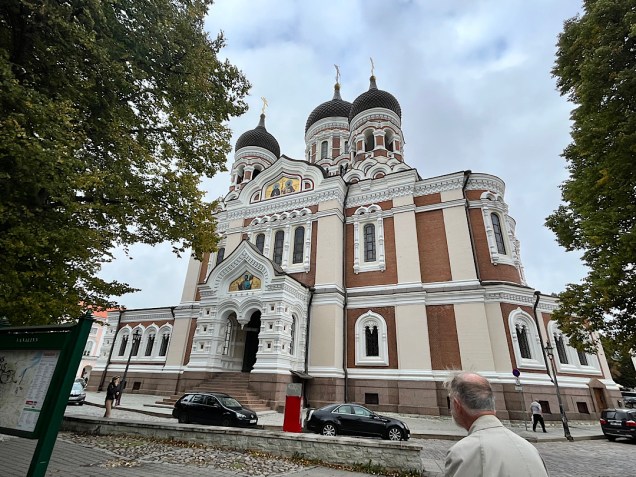

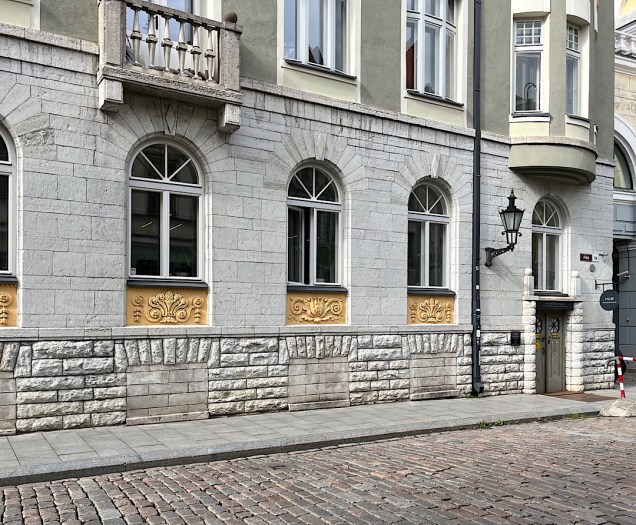
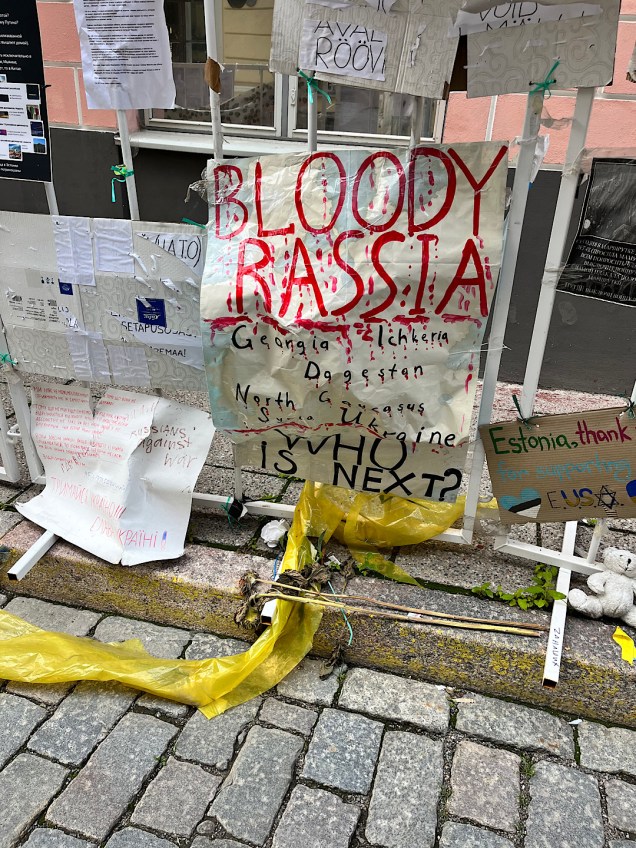
That night we identified the museums we most wanted to visit during our remaining two days. But I also chanced upon a paragraph in my guidebook in which Rick Steves sang the praises of three Tallinn locals offering private guiding services. On impulse, I shot off emails to all three, asking each if he or she might be able to fit us into their schedules. Two of my queries paid off.
Miina Puusepp messaged that she was planning to visit her boyfriend in the seaside spa town of Parnu but would be happy to walk and talk with us for a couple of hours starting at 10 am Wednesday morning. We met her at the entrance to the big, hip marketplace 5 minutes from our apartment. Wearing a (faux?) snakeskin coat and a royal blue hat adorned with a felt flower, Miina immediately challenged us to explain the significance of the Estonia flag we could see in the distance. We were clueless. Turns out that the top (blue) bar represents the sea, the black in the middle represents all the suffering Estonians have historically endured. And the white stripe at the bottom stands for hope that the future will be better. “Under the Soviets, if you wore those colors, that was grounds for being arrested,” Miina stated.
She talked fast, and I spotted the hallmarks of a great guide: strong opinions; deep local knowledge; a sharp sense of humor. Lithuanians, she said, were always harping on their grand ducal history. “If I had a euro for every time I’ve heard about how their country once extended all the way to the Black Sea, I’d be rich,” she said with an eye roll.
She contrasted pretentious Lithuanians with her fellow Estonians. “We’re hobbits. Just leave us alone. If we bump into you in the street we don’t apologize. We hope you didn’t notice.” Within less than 5 minutes, we had a clear fix on Miina’s opinion of Russians (both those in the gigantic country to the east and the hundreds of thousands who are permanent residents of Estonia). Loathing is not too strong a word.
I felt like I could ask her anything. “If you’re born here, does it still bother you when it’s dark almost all the time?” (Just one of the many things I had been wondering.)
“I hate the sun,” she shot back. “I could never live in California. So bright all the time.” She shuddered, then ticked off some of the delights of living where the sun barely appears for months every winter: you can wear a lot of nice clothes; turn your home into a den of uber-coziness; read (which Estonians reportedly do more than any other people on the planet); enjoy the saunas.
From the look of the produce stands all around us, at least in the summer and early fall Miina and her fellow countrymen have access to agricultural bounty that rivals that of SoCal. We took it in for a moment, then whizzed through the market in her wake as she showed us all manner of quirky stuff for sale: the distinctive felt hats folks wear in the sauna to keep their heads from overheating. Reflectors that everyone is legally required to affix to their clothing in winter as a safety measure.
We took it in for a moment, then whizzed through the market in her wake as she showed us all manner of quirky stuff for sale: the distinctive felt hats folks wear in the sauna to keep their heads from overheating. Reflectors that everyone is legally required to affix to their clothing in winter as a safety measure.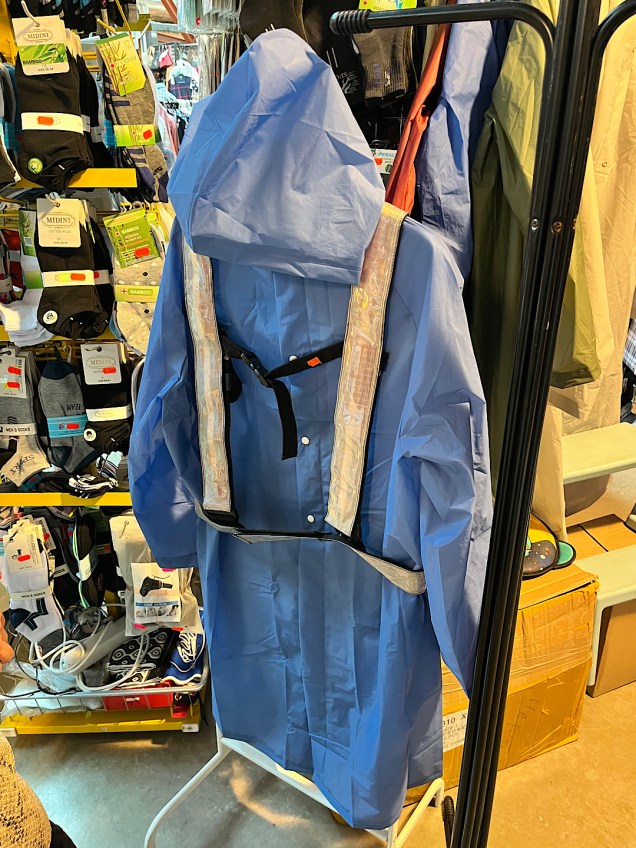
We did so much with Miina in the three hours that followed I won’t try to describe it all. But highlights included taking a city tram to the enormous Kadriorg Park created by Peter the Great for his beloved Catherine (the First).

 Behind the palace is the official residence of the Estonian president. It’s Estonia’s White House (except it’s pink.)
Behind the palace is the official residence of the Estonian president. It’s Estonia’s White House (except it’s pink.)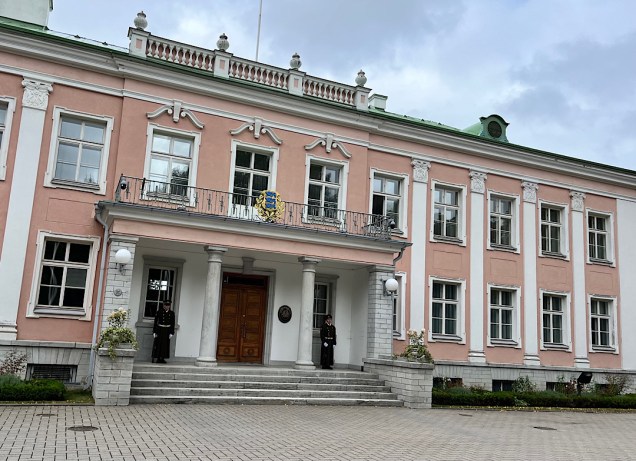
We happened to arrive just before the changing of the guard. Those are the ONLY guards around the residence, by the way.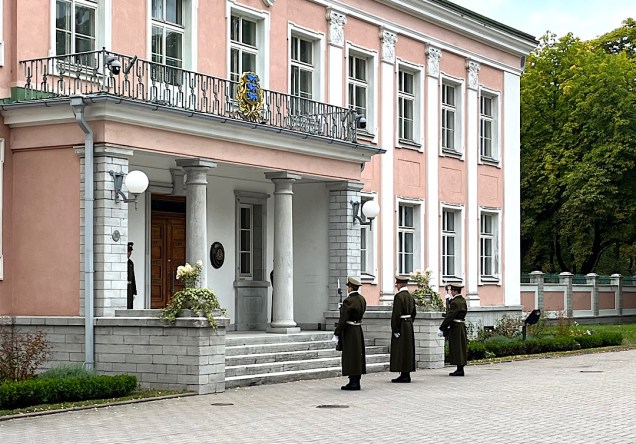 Also charming are the white boxes on the front lawn. They’re bee hives. (Miina said the president is into apiary.)
Also charming are the white boxes on the front lawn. They’re bee hives. (Miina said the president is into apiary.)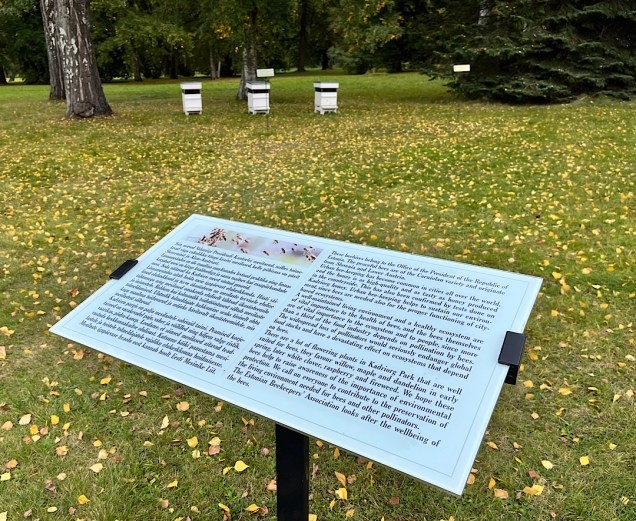 In another part of the park, she led us to the Kumu art museum, a striking limestone, glass, and copper structure that houses the country’s biggest collection of Estonian art.
In another part of the park, she led us to the Kumu art museum, a striking limestone, glass, and copper structure that houses the country’s biggest collection of Estonian art.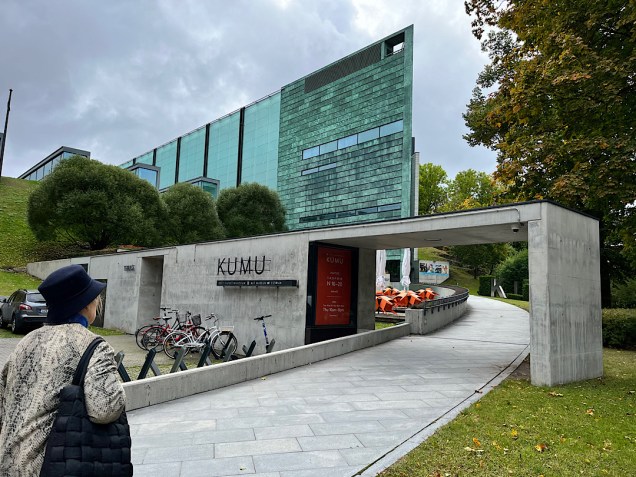

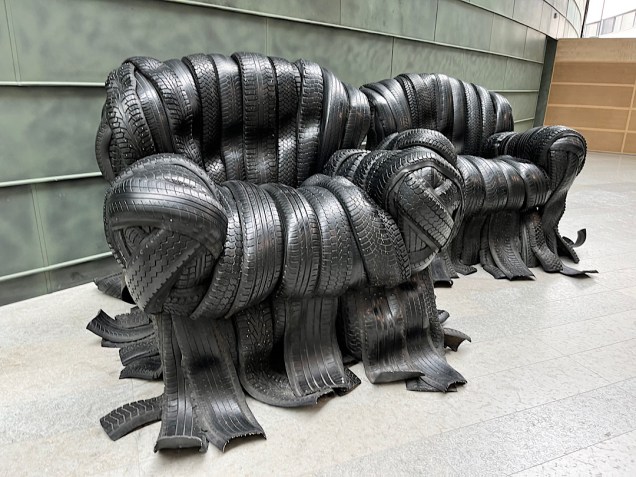
Steve and I would have been happy to part ways with Miina and explore the place. But she had other ideas for what we should do. She led us through more of the park to reach Tallinn’s famous song-festival grounds. We actually were thrilled to see this, as we’d learned what a pivotal role it played in Estonia’s drive for independence from the Soviets in the late 1980s. Unlike its neighbors, the country has an deep tradition of choral song. These are singing hobbits — people say the passion continues today, shared by Estonians of all ages.
In August of 1989, the intensity of people’s hunger for independence drove them to ignore their fears of arrest and gather at the site of a singing festival started 100 years earlier. About 300,000 people filled the festival grounds, about a third of the entire population of Estonia. Attendees complied with the government’s orders and mouthed the requisite musical paeans to Communism, but the program ended with all those voices swelling in a tribute to their love of Estonia — a stunning act of defiance. It didn’t instantly bring independence; that came two years later. But it was the spark.
 An idealistic 20-year-old at the time, Miina was in that crowd, and the emotions of the day played across her face as she told us about it. Then it was time for her to catch the train to the seaside. We said our goodbyes, not before she instructed us in what else we should do that in that afternoon.
An idealistic 20-year-old at the time, Miina was in that crowd, and the emotions of the day played across her face as she told us about it. Then it was time for her to catch the train to the seaside. We said our goodbyes, not before she instructed us in what else we should do that in that afternoon.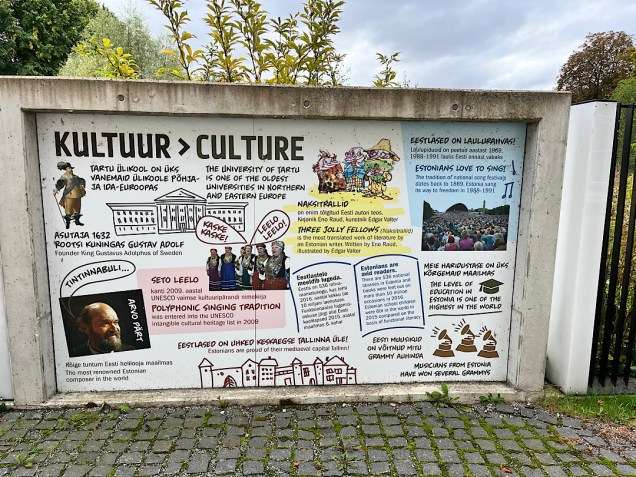

Steve and I loved every minute of our time with Miina. We learned so much I suggested we probably didn’t need to meet the next day with a second guide named Mati Rumessen. He’d been tied up with other work Tuesday but said he’s probably have a couple of free hours Wednesday morning. I wondered aloud to Steve if anything remained for him to show us — we’d already covered so much ground. But Steve was adamant we should get another informed perspective; see if Miina was an outlier in her hatred of the Russians. Get Mati to show us something other than the posh parts of town.

So it was that we climbed into Mati’s black Mercedes Benz van Wednesday morning. Fifty-five years old (born two years before Miina), Mati turned out to be just as entertaining. Maybe he was a tad less blunt than Miina in expressing his hostility to the resident Russians. But the two covered the ground and obviously had similar feelings. Many Russians who marched in to defeat the Nazis stayed, and over the decades, Soviet strategists sent in literal hordes to further “Russify” Estonia. Today Russian and Estonian-speaking residents attend separate schools. A large percentage of the Russians have no interest in learning any Estonian (according to Miina and Mati). As a result, they can’t become citizens or vote, and they resent that. At least Mati could articulate the attitude of many of the Russian Estonians: “My grandfather came here and fought to free you guys from the Nazis! I was born here. This is my country too. Why should I leave?” That widespread attitude combined with Putin’s expressly stated dreams of restoring the historic boundaries of Greater Russia send shivers down Miina and Mati’s spines.
Mati seemed only a bit taken aback by Steve’s request to see some of Tallinn off the tourist path. He gamely drove us into one of the fast shrinking areas that were pillaged and all but destroyed as the Soviets packed up and finally left in 1994.
Mati was just starting out as a taxi driver back then, and he told us how he and his fellow drivers all carried loaded guns to protect themselves against assailants. We drove down streets where every house has now been completely renovated. Now they look great.

Farther from the town center, Mati showed us huge apartment complexes built under Brezhnev to house the Russians sent to Tallinn to work on the 1980 Olympic sailing competitions. Shoddy when built, they’ve also been rehabilitated. Now they house middle-class Russian-Estonians, and they look pretty nice too.
Close to Tallinn’s wide, sandy Pirita Beach, Mati motored past mini-mansions all owned by Russians and all worth more than a million euros apiece. He said Russians own half the property in the Old Town.
We gobbled up all of this, but my favorite parts of our time with Mati were two quick stops toward the end of our time together. One was at the city’s television tower, scene of a frightening standoff in August of 1991 between Russian troops and defenders of the brand-new Estonian republic. Mati was there; he still vividly describes how twitchy the scared young Russian soldiers were, fingers near the triggers of their Kalashnikovs.
After that stop, we entered a wooded area. I asked if it was a park but Mati replied it was a place where all of us will wind up sooner or later — a cemetery. Most of us won’t wind up in any cemetery like this, however. Miina had told us the previous day that Estonians bury their dead in the forest. But I had no idea what she was talking about. Now we were driving through the middle of one. I asked Mati if we could stop so I could take a photo. Now I can say: this is what it looks like.
There may be another place on earth where people find spots among the trees for the remains of their loved ones, but I’ve never seen it. I’m glad we didn’t miss this glimpse of how the hobbits of the far north do it.
A particularly fascinating entry, Jeannette. Thanks!
>
loved this post…great photos, too!
Thanks, Donna!
Thanks, Rich!